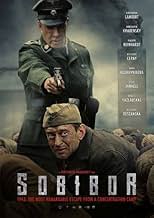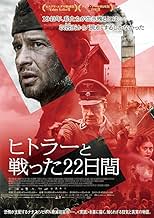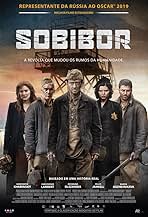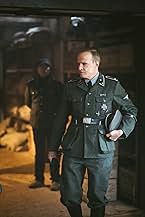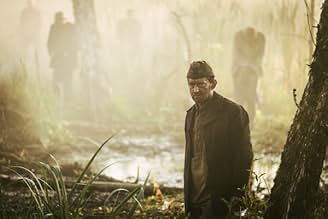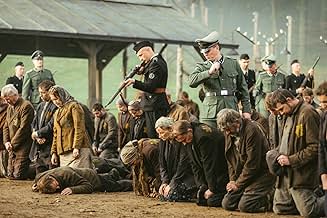IMDb-BEWERTUNG
6,4/10
6093
IHRE BEWERTUNG
Der sowjetische Offizier Alexander Pechersky organisiert im Oktober 1943 einen Aufstand und eine Massenflucht von Häftlingen aus dem Vernichtungslager Sobibór.Der sowjetische Offizier Alexander Pechersky organisiert im Oktober 1943 einen Aufstand und eine Massenflucht von Häftlingen aus dem Vernichtungslager Sobibór.Der sowjetische Offizier Alexander Pechersky organisiert im Oktober 1943 einen Aufstand und eine Massenflucht von Häftlingen aus dem Vernichtungslager Sobibór.
- Auszeichnungen
- 3 wins total
Konstantin Khabensky
- Alexander Pechersky
- (as Konstantin Khabenskiy)
Dainius Kazlauskas
- Leo
- (as Daynos Kazlauskas)
Michalina Olszanska
- Hanna
- (as Mikhalina Olshanska)
Mariya Kozhevnikova
- Selma
- (as Maria Kozhevnikova)
Yakov Mulerman
- Moses
- (as Jaa Mulerman)
Joshua Rubin
- Jakob
- (as Jowe Ruby)
Fabian Kociecki
- Chaim
- (as Fabian Kochenski)
Wolfgang Cerny
- Gustav Wagner
- (as Wolfgang Cherny)
Philippe Reinhardt
- Siegfried Greitschus
- (as Philip Reinhardt)
Wieslaw Cichy
- Józef
- (as Weslav Kichi)
Empfohlene Bewertungen
Holocaust films are easily made exploitive, because, in the words of the late and great Roger Ebert,, "we do not need movies to convince us of the evil of ... the Holocaust," but rather, it is a subject better served in "films ... about the ways good men try to work realistically within an evil system to spare a few of its victims." To merely recount the violence that human beings are capable of perpetuating against each other makes for transgressive reflection rather than a useful one, because it denies us hope. Sobibor passes Ebert's test: From the first scene to the last, the horrors of the Holocaust are contrasted against the humanity of its victims and the courage that they ultimately find to rise up and fight back. It helps that the Sobibor camp is more cinematically satisfying, as it represents one of the only successful uprisings in concentration camps - 400 prisoners successfully escaped, led by Russian soldier Alexander Pechersky, and the third act breakout generates genuine tension as the heroes slowly begin to implement a plan that begins with individual acts of violence and ends with a convincing revolution. It is one of the great prison-breaks in the movies, made all the more jaw-dropping when the closing scroll reminds us that it is all true. In contract, Inglorious Basterds (a great film) had to create a fantasy ending that was as emotionally satisfying as the history featured in Sobibor.
The scenes leading up to the escape depict the daily lives of both soldiers and prisoners within the camp, in both its banalities and horrors, and there are some truly gory and disturbing moments here, but they never feel unnecessary because of the way that lead actor/director Konstaintin Khabenskiy depicts these events through the eyes of the prisoners who, slowly but surely, refuse to be victims any longer. Khabenskiy makes for a dogged and convincing hero, but it is Christopher Lambert's depiction of Karl Frenzel, the Nazi administrator of the camp, that really elevates the film's tension-Lambert plays the part as a man barely holding onto his sanity, having internalized the suffering that he constantly orders and witnesses. It is the most chilling portrait of an unhinged Nazi official since Ralpph Fiennes in Schindler's List. Less successful is Khabenskiy's decision to suggest a romantic connection between Pechersky and a female prisoner that he knew before the war, mainly because I struggled to believe an opportunity for such a romance convincing in this setting; nevertheless, this relationship is well-acted and leads to one of the best character exchanges in the film.
Sobibor is the Russian submission for the 91st Academy Award for best foreign language film. The film was shot in Lithuania, in six languages: Russian, Polish, German, Dutch, Yiddish, and English. This helps give the film the epic scope of a truly international production, and that is exactly what it feels like. This is one of the best films centered on the theme of the Holocaust that I have ever seen-well-acted, handsomely stages, filled with sobering imagery, and ultimately, a satisfying resolution that makes an often difficult journey worth taking. What begins as a tragedy ends as a victory; the film's success, and whether or not we accept the set-up of the first two acts, hinges on the execution of the escape. Khabenskiy absolutely delivers. I would be very happy to see this film appear on the list of nominees.
Riveting true story of the only successful revolt of a Nazi extermination camp. This film shows the pure evil of the Nazi's, the struggles of various prisoners to either find balance or reconcile their faith with what must be done for the survival of themselves or their loved ones.
This stuff still happens today with different clowns in the role of evil idiot!
Christopher Lambert stars as Karl Frenzel SS non-commissioned officer in Sobibór who was sentenced to life imprisonment for his part in killing 150,000 jews until he was released in 1985 for poor health but died in retirement home near Hannover in 1996. The film shows the horrors of the camp and the plan to escape and the resulting escape but not as good as original film. The end titles were hard to read, but when i did were very interesting.
..to watch these sort of films no matter how hard it might be.
As we should never forget what happened in these World War 2 concentration camps.
As we should never forget what happened in these World War 2 concentration camps.
Interesting movie about the known breakout from horrible concentration camp .This notable movie deals with extermination center Sobibór and the subsequent getaway. As Soviet officer Alexander Pechersky leads and organizes a revolt and mass escape of prisoners from Sobibór extermination camp in October 1943 . We see horrors , murders and slaughters against the disgraced prisoners who live with the spectre of a violent and sudden death . Thus , when the incoming transports , mostly Jews , SS soldiers made instant decisions , those who were fit to labors were sent into the camp , others including the children , were dispatched immediately to the gas chambers where approximately one-quarter million Jews were executed . Every day the prisoners have to endure untold cruelty at the hands of the guards and . The flick is nicely starred by Konstantin Khabenskiy as prisoner Alexander Pechersky and Christopher Lambert as ruthless commandant Karl Frenzel . Remaining support cast , though unknown provide fine interpretations. The movie contains an engaging storyline based on the book by Ilya Vasiliev: "Alexander Pechersky: Breakthrough to Immortality" , getting a breathtaking and exciting getaway with a sensitive musical score . The film was well realized , developing compellingly the historical recreation of the tortures , distresses , penury , mistreats and massacres of the unfortunate prisoners and eventually the famous escape from the Nazi Death Camp Sobibor . The motion picture was professionally directed by Konstantin Khabenskiy who also stars an essential role giving nice acting . There's another version about this events ¨Escape from Sobibor¨ (1987) by Jack Gold with great actors as Alan Arkin , Joanna Pacula and Rutger Hauer .
The picture is based on real events , these are the following ones : Sobibór , Chelmno , Belzec and Treblinka were four large death camps in the Lublin district of Poland transformed into extermination centers to implement the policy of genocide thought at the Wannsee Conference . Sobibór was an extermination camp of killing center of Jews , part of their Final Solution , including children and located near the Bug River on the border of the German occupied eastern territories . Some 35.000 Dutch Jews , originally assigned to Auschwitz were sent to Sobibór . All four camps were under the command of SS Odilo Globocnick . There was some minor industrial activity linked to the war effort but the main work was the execution of inmates . Victims were brought to the camp in unventilated transports , and all but a handful were gassed after arrival , the gas chambers could accommodate hundred prisoners at one time , most of their corpses were burned in open pits . On October 14, 1943 about 150 inmates broke out in a desperate riot . Of approximately 600 prisoners who attempted escaped in October 1943 , around 300 succeeded . However, nearly all were ultimately recaptured ; only about 60 people survived . Sobibor along with Treblinka and Belzec , was evacuated in the fall of 1943.
The picture is based on real events , these are the following ones : Sobibór , Chelmno , Belzec and Treblinka were four large death camps in the Lublin district of Poland transformed into extermination centers to implement the policy of genocide thought at the Wannsee Conference . Sobibór was an extermination camp of killing center of Jews , part of their Final Solution , including children and located near the Bug River on the border of the German occupied eastern territories . Some 35.000 Dutch Jews , originally assigned to Auschwitz were sent to Sobibór . All four camps were under the command of SS Odilo Globocnick . There was some minor industrial activity linked to the war effort but the main work was the execution of inmates . Victims were brought to the camp in unventilated transports , and all but a handful were gassed after arrival , the gas chambers could accommodate hundred prisoners at one time , most of their corpses were burned in open pits . On October 14, 1943 about 150 inmates broke out in a desperate riot . Of approximately 600 prisoners who attempted escaped in October 1943 , around 300 succeeded . However, nearly all were ultimately recaptured ; only about 60 people survived . Sobibor along with Treblinka and Belzec , was evacuated in the fall of 1943.
Wusstest du schon
- WissenswertesThe film was shot at once in five languages: Russian, Polish, German, Dutch and Yiddish.
- PatzerFrom approximately 30:55 to 32:52 Alexander Pechersky is chopping a tree in a swamp. The tree eventually falls. At 44:13 he chopping the same tree which is back in its standing position.
- Alternative VersionenThere are three versions. These are the running times for them: "1 hr 58 min (118 min), 1 hr 50 min (110 min) (Russia),1 hr 40 min (100 min) (South Korea)".
- VerbindungenReferenced in Vdud (2017)
Top-Auswahl
Melde dich zum Bewerten an und greife auf die Watchlist für personalisierte Empfehlungen zu.
Details
- Erscheinungsdatum
- Herkunftsländer
- Offizieller Standort
- Sprachen
- Auch bekannt als
- Trại Tử Thần
- Drehorte
- Produktionsfirmen
- Weitere beteiligte Unternehmen bei IMDbPro anzeigen
Box Office
- Weltweiter Bruttoertrag
- 5.096.619 $
Zu dieser Seite beitragen
Bearbeitung vorschlagen oder fehlenden Inhalt hinzufügen


